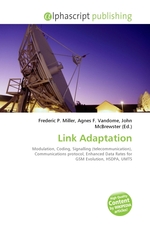Link Adaptation
Frederic P. Miller, Agnes F. Vandome, John McBrewster
бумажная книга
High Quality Content by WIKIPEDIA articles! Link adaptation, or adaptive coding and modulation, is a term used in wireless communications to denote the matching of the modulation, coding and other signal and protocol parameters to the conditions on the radio link. For example, EDGE uses a rate adaptation algorithm that adapts the modulation and coding scheme according to the quality of the radio channel, and thus the bit rate and robustness of data transmission. The process of link adaptation is a dynamic one and the signal and protocol parameters change as the radio link conditions change -- for example in HSDPA in UMTS this can take place every 2 ms. Adaptive modulation systems invariably require some channel state information at the transmitter. This could be acquired in time division duplex systems by assuming the channel from the transmitter to the receiver is approximately the same as the channel from the receiver to the transmitter. Alternatively, the channel knowledge can also be directly measured at the receiver, and fed back to the transmitter.
Данное издание не является оригинальным. Книга печатается по технологии принт-он-деманд после получения заказа.


